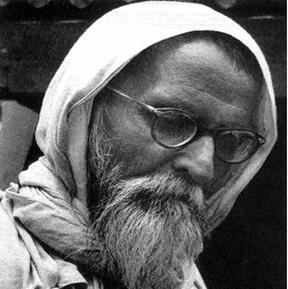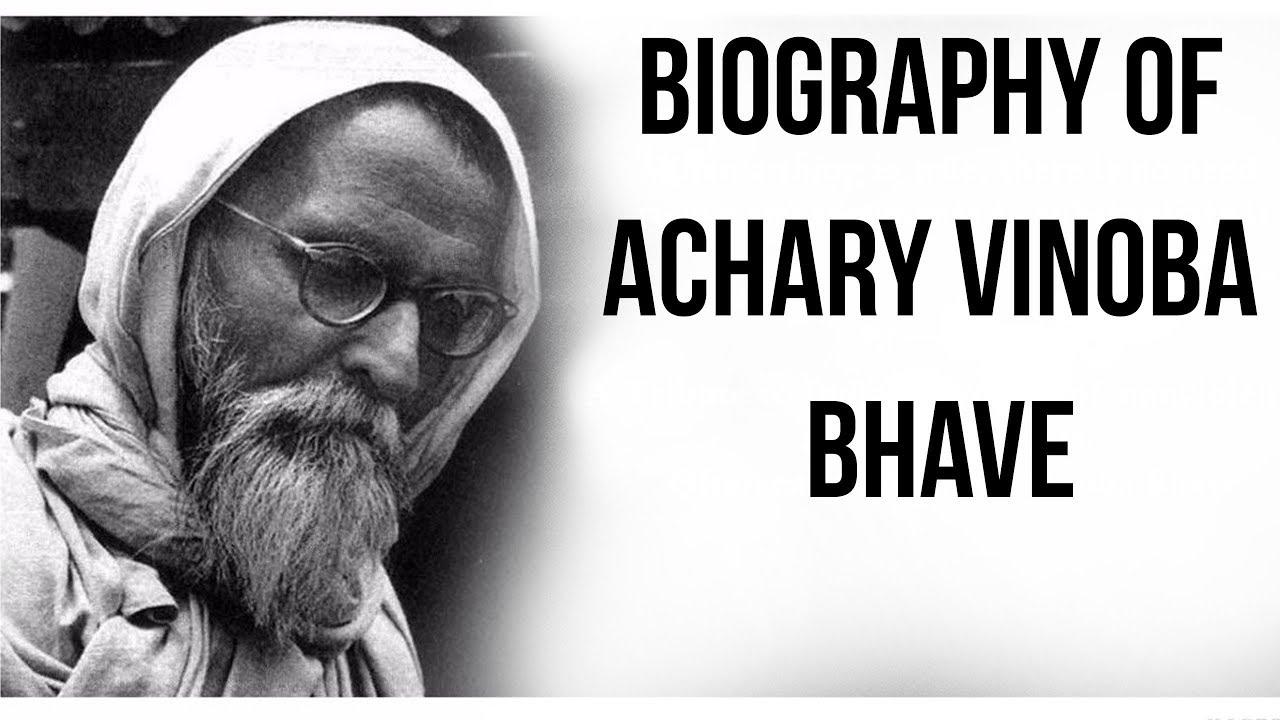Table of Contents
EARLY LIFE

- Vinayaka Narahari Bhave was born on 11 September 1895 in a small village called Gagoji in Kolaba in the Konkan region of what is now Maharashtra.
- Vinayaka was the eldest son of Narahari Shambhu Rao and Rukmini Devi. The couple had five children; four sons named Vinayaka , Balakrishna, Shivaji and Dattatreya, and one daughter.
- His father was a trained weaver with a rationalist modern outlook, and worked in Baroda. Vinayaka was brought up by his grandfather, Shamburao Bhave and was greatly influenced by his mother Rukmini Devi, . Vinayaka was highly inspired after reading the Bhagavad Gita, at a very young age.
EARLY LIFE
- A report in the newspapers about Gandhi’s speech at the newly founded Benaras Hindu University attracted Bhave’s attention. In 1916, on his way to Mumbai to appear for the intermediate examination, Bhave threw his school and college certificates into a fire.
- Bhave took the decision after reading the piece of writing in the newspaper written by Mahatma Gandhi. He wrote a letter to Gandhi and after an exchange of letters, Gandhi advised Bhave to come for a personal meeting at Kochrab Ashram in Ahmedabad.
- Bhave met Gandhi on 7 June 1916 and subsequently abandoned his studies.
ACHARYA
- Bhave participated with keen interest in the activities at Gandhi’s ashram, like teaching, studying, spinning and improving the life of the community.
- His involvement with Gandhi’s constructive programmes related to Khadi, village industries, new education (Nai Talim), sanitation and hygiene also kept on increasing.
- Bhave went to Wardha on 8 April 1921 to take charge of the Ashram as desired by Gandhi.
- Bhave was arrested several times during the 1920s and 1930s and served a five-year jail sentence in the 1940s for leading non-violent resistance to British rule. He wrote Ishavasyavritti and Sthitaprajna Darshan in jail.
ACHARYA
- He was associated with Mahatma Gandhi in the Indian independence movement. He stayed for some time at Gandhi’s Sabarmati ashram in a cottage that was named after him, ‘Vinoba Kutir’. There he gave a series of talks on the Gita, in his native language Marathi, to his fellows.
- These highly inspiring talks were later published as the book “Talks on the Gita”, and it has been translated into many languages both in India and elsewhere.
- In 1940 he was chosen by Gandhi to be the first individual Satyagrahi against the British rule. It is said that Gandhi envied and respected Bhave’s celibacy, a vow he made in his adolescence, in fitting with his belief in the Brahmacharya principle. Bhave also participated in the Quit India Movement.
SPIRITUAL SCHOLAR
- The jails for Vinoba had become the places of reading and writing. He saw the proofs of his book `Gitai’ (Marathi translation of Gita) in the Dhulia jail.
- Lectures given by him on Gita to the colleagues in the Dhulia jail collected by Sane Guruji were later published as a book. Writing of the book “Swarajya Shastra” (the treatise of self rule) and the collection of the bhajans (religious songs) of the saint Gyaneshwar, Eknath and Namdev were completed.
- In Nagpur jail, `Ishavasyavritti’ and `Sthitaprajna Darshan’ were written in the Seoni jail
SARVODAYA
- In March 1948, Gandhi’s followers and constructive workers met at Sevagram. The idea of Sarvodaya Samaj (society) surfaced and started getting acceptance.
- In the beginning of 1950, he launched the programme of kanchan-mukti (freedom from dependence on gold, i.e. money) and Rishi-Kheti (cultivation without the use of bullocks as was practised by Rishis, i.e. the sages of ancient times).
- In April 1951, after attending the Sarvodaya conference at Shivnampalli, he started his peace-trek on foot through the violence-torn region of Telangana(now in Andhra Pradesh). The disturbances were caused by the communists. On April 18, 1951, his meeting with the villagers at Pochampalli opened a new chapter in the history of non-violent struggle.
SARVODAYA
- Bhave’s religious outlook was very broad and it synthesised the truths of many religions. This can be seen in one of his hymns “Om Tat Sat” which contains symbols of many religions. His slogan “जय जगत्” (Jay Jagat) i.e. “victory to the world” finds reflection in his views about the world as a whole.
- Bhave observed the life of the average Indian living in a village and tried to find solutions for the problems he faced with a firm spiritual foundation. This formed the core of his Sarvodaya movement.
BHOODAN MOVEMENT
- In 1951, Vinoba Bhave started his peace-trek on foot through the violence-torn region of Telangana.
- On April 18, 1951, the Harijans of the Pochampalli village requested him to provide them with around 80 acres of land to make a living. Vinoba asked the landlords of the village to come forward and save the Harijans.
- To everybody’s surprise, a landlord got up and offered the required land. This incident added a new chapter in the history of sacrifices and non-violence. It was the beginning of the Bhoodan (Gift of the Land) movement.
- The movement continued for thirteen years and Vinoba toured the length and breadth of the country, a total distance of 58741 Km. He was successful in collecting around 4.4 million acres of land.
FINAL YEARS AND IDEOLOGY
- After traveling through India, he returned to Paunar on November 2, 1969 and on October 7, 1970, he announced his decision to stay in one place. He observed a year of silence from December 25, 1974 to December 25, 1975.
- In 1976, he undertook a fast to stop the slaughter of cows. His spiritual pursuits intensified as he withdrew from the activities. He breathed his last on November 15, 1982 at this ashram.
- As against it has to be noted that Vinoba’s movement rekindled faith in non-violence and human values advocated by Gandhi.
- He connected science with spirituality and the autonomous village with the world movement. He regarded the power of the people superior than power of the state.
DEATH
In 1958 Bhave was the first recipient of the international Ramon Magsaysay Award for Community Leadership. He was awarded the Bharat Ratna posthumously in 1983

























 WhatsApp
WhatsApp